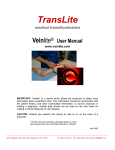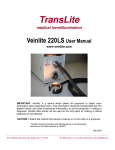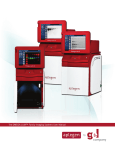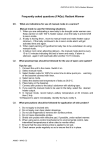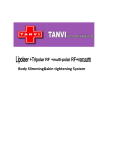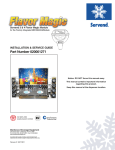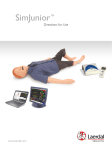Download TransLite medical transillumination
Transcript
TransLite medical transillumination Veinlite 220 P User Manual www.veinlite.com IMPORTANT: Veinlite* is a device which allows the physician to obtain more information about superficial veins. This information should be incorporated with the patient history, and other examination information, to aid the physician in making a diagnosis. Veinlite data should not be used as the only basis for making a clinical diagnosis of vein disease. CAUTION: Federal law restricts this device to sale by or on the order of a physician. *Veinlite uses the same fiber optic light design as in the Nevoscope which has a US Patent Number 5,146,923. May 2003 ____________________________________________________________________________________________________________ 8410, Highway 90A, Suite 150, Sugar Land, TX 77478 Tel: (281) 240-3111, Fax: (281) 240-3122, E-mail: [email protected] Contents Page 1. Table of Contents 2 2. Introduction 3 3. Description of Veinlite illumination technique 4 4. Operating Instructions 5 5. Care and Maintenance (a) Cleaning Instructions 6 (b) Light Source 6 6. The Use of Veinlite for Pediatric Applications 7 7. Summary of Veinlite Operation 8 8. Veinlite P Specifications 9 2 2. Introduction Superficial veins that are less than 3 mm deep can sometimes be seen as blue-green (often raised) areas of the skin. Visualization of these veins is determined by the type of light used and the properties of the skin, which reflects shorter wavelength light (blue and green) and absorbs longer wavelength light (orange and red). The light reflected by the surface of the skin is intense enough to over power the light transmitted by the skin, thus limiting the visualization of superficial veins to depths of a few millimeters. There are two ways of reducing the reflected light and better visualizing the deeper veins. The first method uses cross-polarization of the surface light to reduce the amount of light reflected by the skin surface, which permits better visualization of the deeper veins. In this method, the light source is linearly polarized in one axis and the viewing lenses are rotated in polarization by 90 degrees to cancel most of the reflected light. Not all the reflected light is cancelled so the imaging of some of the deeper and smaller veins is limited. The second method uses transillumination to eliminate surface reflected light and make the skin translucent. In the transillumination method, a light source is placed in contact with the skin and directed at it. The orange and red light enter the skin and are diffracted in the tissue. The depth of penetration of the light depends on its wavelength. Yellow light (which has a relatively short wavelength, compared to red light) travels a much shorter distance than the red light which penetrates deeper. Transillumination has been used for many years to image subsurface veins and some other structures. A bright light is directed into the skin and the area of interest is examined by viewing the translucent region around the light. In some cases, the transmitted light is used to view deeper structures. The Venoscope device, marketed for visualization of veins, uses two light sources to image the veins. While this device works better than a single light source, areas of shadow are created between the light sources, due to the non-uniform illumination. The TransLite Veinlite uses a new transillumination technique, called sidetransillumination, for better visualization of veins. Using this technique, the Veinlite is able to uniformly transilluminate a small region of the skin, so that much better imaging of veins is achieved without shadows. This technique is described below. 3 3. Description of Veinlite illumination technique The TransLite Veinlite is a new imaging device that uses the same new patented side-transilluminating technique as the Nevoscope**. Side transillumination is a technique whereby a ring of bright fiber optic light is directed into the skin, at an angle such that the light is focused under the skin. The focused light creates a virtual light source under the skin, uniformly transilluminating the skin inside the ring light opening. viewer bright light source bright light source skin surface vein virtual light source Figure 1. Side-Transillumination **Veinlite uses the same patented side-transillumination technique used in the Nevoscope, which has a US Patent Number 5,146,923. 4 4. Operating Instructions The Veinlite comprises a halogen light source, a 6ft flexible fiber-optic cable and a patented ring illuminator (ring light) for side-transillumination. The light source uses a 150 watts halogen bulb and has a potentiometer for adjustment of illumination level. Light is channeled through the fiber-optic cable to the specially designed ring light which directs it under the skin. The Veinlite is designed to operate in two modes: side-transillumination mode and transmission transillumination mode. • The side-transillumination mode is achieved by placing the ring light directly in contact with the skin in the area of interest, i.e. above the vein to be visualized. Gentle pressure should be applied to the Veinlite ring to make good skin contact and assure maximum light transfer into the skin. • The transmission illumination mode is achieved by placing the ring light against the palm of the hand or the sole of the foot so the light shines through to the dorsum, illuminating the veins in the dorsum. To use the Veinlite for visualizing veins, first visually locate the approximate region of interest of the skin and then position the ring light over it. • Always turn the illumination level down to a minimum before turning on the power to the light source. This minimizes transient power surges that can destroy the filament of the light bulb. • Turn off overhead fluorescent lights which interfere with transillumination. • Always use the lowest light intensity while positioning the ring light on the skin. Once positioned, the intensity can be adjusted to the desired level. • Bright light is useful for visualizing small surface veins in the field of view. • Low light level is useful for visualizing deeper veins. For best results in mapping reticular and feeder veins, turn off the overhead lights. • Apply gentle pressure to the ring to ensure it is in contact with the skin. Veins can also be viewed by blocking the area inside the ring with a gauze pad and viewing the region outside the ring. • Long veins can be visualized using this method. CAUTION: Do not look directly at the ring light when it is illuminated. 5 5. Care and Maintenance 5. (a) Cleaning Instructions CAUTION: Always turn the light source off before cleaning the Veinlite. The light ring (which comes into contact with the patient’s skin) should be cleaned using 70% Isopropyl alcohol or other medically accepted disinfectant. The Veinlite light source box and cable may be decontaminated by using standard phenol based or other medically accepted cleaning solutions. • Use liberal amounts of solution to clean the Veinlite box and cable. • Wipe with sterile water or Isopropyl alcohol to remove any residues. • The Veinlite is water-resistant but not waterproof. • Do not use abrasive material on any part of the equipment or immerse the device in liquid. • Do not autoclave the Veinlite. Special Veinlite systems, designed to be autoclaved, are available. Contact your supplier for more information. 5. (b) Light Source CAUTION: Do not look directly into the light. The light source contains a bright halogen lamp that has a limited life-time. • Use the potentiometer on the light box to control the light level. • Always turn the light source off when not in use. Replacement of the light bulb should be carried out with extreme caution. • Always disconnect the power from the light source box and allow the unit to cool down for at least an hour before changing the light bulb. • When handling the light bulb, wear a glove to avoid getting skin oil onto the bulb surface. Do not touch the inner surface of the bulb. • Undo the large screw on top of the light source box and pull the front cover plate forwards. • Push the small lever (next to the light bulb) backwards to raise the bulb slightly out the metal clamp which holds it in place. • Gently remove the light bulb from the holding clamp and disconnect the plug from the back of the bulb. • Position a new light bulb in the clamp and reconnect the plug. • Push the lever back to its original position so that the light bulb will be properly seated for illuminating the fiber optic cable. • Replace the front cover on the light source box and fasten the screw on the top of the box before reconnecting the unit to the AC power supply. 6 6. The Use of Veinlite for Pediatric Applications Veinlite can be utilized to facilitate pediatric venous access. There are two methods which can be used for this application: the standard or side-transillumination method and the transmission transillumination method. In the side-transillumination method, the Veinlite ring is placed on the skin, at the probable location of the vein to be visualized, and then the light level is increased. Venous access can be made while visualizing the veins in this way. In the transmission transillumination method, the Veinlite ring light is placed in the palm of the hand and the light is allowed to transilluminate through to the dorsum of the hand. This method allows visualization of most of the veins in a small hand therefore it works best with infants and small children. It is useful in cases where there is a lot of subcutaneous fat. The transmission method can also be used to visualize veins in the foot. Please remember to turn off the overhead fluorescent lights or shield against these lights since they reduce the efficacy of the transillumination. Figure 2. Vein localization using Side-Transillumination IMPORTANT: Veinlite is a device that allows the physician to obtain more information about superficial veins. This information should be incorporated with the patient history, and other examination information, to aid the physician in making a diagnosis. Veinlite data should not be used as the only basis for making a clinical diagnosis. CAUTION: Federal law restricts this device to sale by or on the order of a physician or other qualified health care professional. 7 7. Summary of Veinlite Operation 1. Turn Overhead Lights Off Overhead lights can overpower the transillumination effect from the Veinlite. For best results in viewing detailed surface venous distribution, switch the overhead light off and turn other room lights low. 2. Positioning the Veinlite Position the Veinlite in the area of interest. Apply a gentle pressure on the Veinlite so that it is in contact with the skin. Make sure that the light intensity is turned low during positioning. 3. Viewing Surface Veins Bright light is useful for visualizing small surface veins in the field of view. Low light level is useful for visualizing deeper veins. For best results in mapping reticular and feeder veins, adjust the light intensity level for optimum imaging. 4. Viewing Veins Outside the Veinlite Ring Illuminator Veins lying outside the ring illuminator can also be viewed by blocking the circular area of illumination with a gauze pad and viewing the region outside the ring light. Long veins can be visualized using this method. 5. Cleaning Clean the Veinlite ring illuminator before and after use, using 70% Isopropyl alcohol or other medically accepted disinfectant. Decontaminate the ring light and the fiber optic cable using standard phenol based solutions. The Veinlite is designed to be waterproof and liberal amounts of fluids can be used during decontamination. Do not immerse the Veinlite in liquids or use it in an autoclave. 6. Caution Caution is advised in handling of the ring light source to avoid any possible injury to the eye from the bright light. Always turn the illumination level down to a minimum while handling Veinlite. DO NOT LOOK DIRECTLY INTO THE LIGHT 8 8. Veinlite P Specifications The Veinlite P model comes with the same halogen light source as the regular model but has a smaller ring illuminator attachment than the standard model. This specially designed ring illuminator has a focal spot that is approximately 6mm below the surface, providing very bright and uniform illumination of smaller, shallower veins, as are found in babies and children. Its concentrated light provides a good source for transmission transillumination and its small size allows it to be placed in the palm of a child’s hand, therefore it is optimal for use in pediatrics. The small ring illuminator can also be used on parts of the body where the skin surface has a steeply curving contour and for small areas of interest. It can be used for mapping surface veins in adults as well as for finding veins in babies and children. For optimal tracking of long veins, block the center of the ring with a gauze pad and view the vein using the light outside the ring. Figure 3 Veinlite P Fiberoptic Cable and Small Ring Illuminator TransLite Veinlite P Specifications Ring Top Diameter (outer) Ring Top Diameter (inner) Ring Bottom Diameter (inner) Fiber Taper Angle Light Window Width Fiber Optic Length Light Source Power Power Output Adjust Input Voltage Approximate Color Temperature 38 mm 27 mm 18 mm 45 Degrees 0.5 mm 6 feet 150 Watts Rheostat Continuously Variable 220-240 volts, 50-60 Hz AC 3250 degrees (At Max. Level) __________________________________________________________________________________________________________ Tel: (281) 240-3111, Fax: (281) 240-3122, E-mail: [email protected] 8410, Highway 90A, Suite 150, Sugar Land, TX 77478 9









